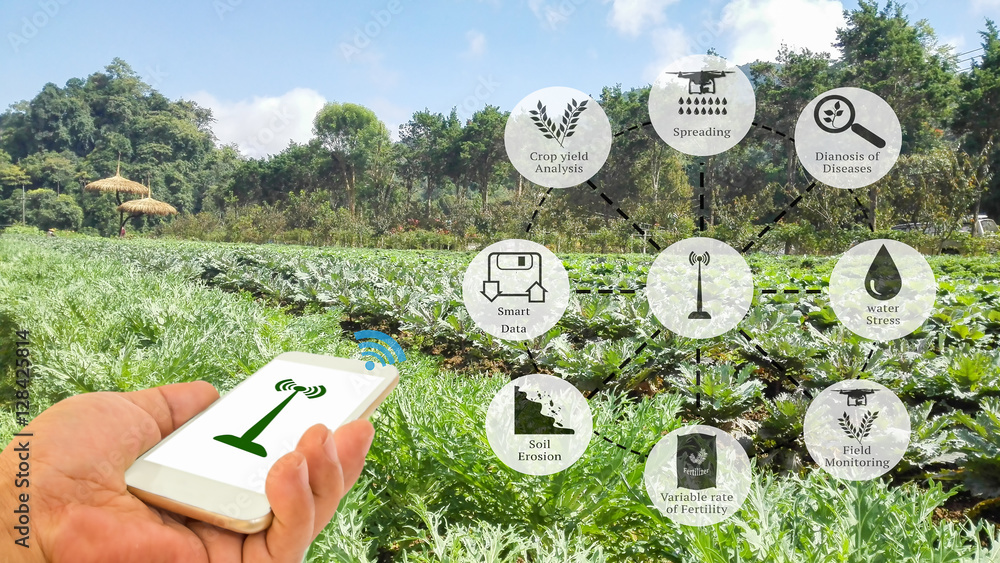Smart Irrigation Systems have emerged as a transformative force in agriculture, promising to revolutionize the way we approach water usage on farms. In a world grappling with the dual challenges of feeding a growing population and mitigating the impacts of climate change, the integration of technology into agriculture has become an imperative.
This extensive article aims to delve deeply into the intricacies of Smart Irrigation Systems, providing an exhaustive exploration of their components, working mechanisms, benefits, challenges, case studies, future trends, and the role they play in water conservation through AgriTech innovation.

Understanding Smart Irrigation Systems:
Definition and Components:
Smart Irrigation Systems, at their core, represent a fusion of advanced technologies designed to enhance the efficiency of water use in agriculture. These systems comprise several key components, each playing a vital role in optimizing irrigation practices.
Definition of Smart Irrigation Systems:
Smart Irrigation Systems refer to a technologically driven approach to water management in agriculture, employing sensors, controllers, and communication systems to enhance the precision and efficiency of irrigation processes.
Key Components: Sensors, Controllers, Actuators, Communication Systems:
- Sensors: These devices are instrumental in collecting real-time data from the environment, including soil moisture levels, weather conditions, and crop health indicators. Soil moisture sensors, weather sensors, and crop sensors collectively contribute to a comprehensive understanding of the agricultural landscape.
- Controllers: The brain of the system, controllers process the data collected by sensors and make informed decisions regarding when, where, and how much water to apply. Advanced controllers utilize data analytics and machine learning algorithms for optimal irrigation scheduling.
- Actuators: Responsible for the physical execution of irrigation, actuators regulate the flow of water based on the decisions made by controllers. This ensures that water is delivered precisely where and when it is needed.
- Communication Systems: The seamless exchange of data between sensors, controllers, and actuators is facilitated by communication systems. This often involves Internet of Things (IoT) technologies, allowing for real-time monitoring and control.
Types of Smart Irrigation Systems:
Smart Irrigation Systems come in various types, each tailored to address specific agricultural needs and conditions.
Weather-based Irrigation:
This type of system relies on real-time weather data to determine optimal irrigation schedules. By considering current weather conditions and forecasting trends, the system adjusts irrigation to match the immediate and future needs of the crops.
Soil Moisture-based Irrigation:
Soil moisture sensors play a central role in these systems, providing crucial information about the water content in the soil. Irrigation is triggered based on actual soil conditions, ensuring that crops receive water precisely when it is required.
Automated Irrigation Scheduling:
These systems utilize data analytics and machine learning algorithms to create customized irrigation schedules. By considering factors such as crop type, soil characteristics, and weather forecasts, these systems optimize irrigation timing and duration for maximum efficiency.
How Smart Irrigation Systems Work:
Sensor Technology:
Soil Moisture Sensors:
Soil moisture sensors are pivotal in assessing the water content in the soil, providing essential data for irrigation decision-making. These sensors can be placed at various depths to capture a comprehensive picture of soil moisture distribution.
Weather Sensors:
Weather sensors collect data on temperature, humidity, wind speed, and precipitation. This information is critical for understanding the external conditions influencing crop water requirements. Advanced systems may integrate satellite data and weather forecasting models for more accurate predictions.
Crop Sensors:
Crop sensors monitor the health and growth of plants. By measuring parameters such as leaf temperature, chlorophyll content, and canopy size, these sensors provide insights into the water needs and overall condition of the crops.
Data Collection and Analysis:
Integration of IoT:
The Internet of Things (IoT) plays a pivotal role in Smart Irrigation Systems, enabling seamless communication and data exchange among various components. Sensors transmit real-time data to controllers, which, in turn, make data-driven decisions for precise irrigation management.
Data Analytics for Decision-making:
The collected data undergoes thorough analysis using advanced analytics tools. Machine learning algorithms may be employed to identify patterns, correlations, and trends, helping the system make informed decisions about irrigation scheduling, water allocation, and resource optimization.
Precision Watering:
The culmination of sensor data and analytics results in precision watering. This involves delivering the right amount of water to specific areas of the field, ensuring that crops receive optimal hydration without wastage.
Benefits of Smart Irrigation Systems:
Water Conservation:
Reduction in Water Wastage:
One of the primary objectives of Smart Irrigation Systems is to minimize water wastage. By precisely tailoring irrigation to actual crop needs, these systems eliminate overwatering, reducing the strain on water resources.
Precision Irrigation for Optimal Water Usage:
The ability to target irrigation based on real-time data allows for optimal water usage. Smart systems adapt to changing conditions, ensuring that water is applied when and where it is most needed.
Sustainable Agriculture Practices:
Smart Irrigation contributes to the promotion of sustainable agriculture. By conserving water, these systems align with environmentally conscious farming practices, mitigating the impact of agriculture on local ecosystems.
Increased Crop Yield:
Improved Plant Health:
The precise delivery of water and nutrients enhances plant health. Smart Irrigation Systems prevent underor over-watering, reducing the risk of water stress, diseases, and nutrient deficiencies.
Enhanced Nutrient Absorption:
Optimal irrigation ensures that nutrients in the soil are effectively absorbed by plants. This leads to improved crop development, increased yields, and better overall quality of produce.
Minimized Water Stress:
Smart Irrigation helps alleviate water stress on crops by maintaining consistent moisture levels. This is particularly crucial during critical growth stages, resulting in healthier and more resilient plants.
Resource Efficiency:
Energy Savings:
By minimizing unnecessary water pumping and distribution, Smart Irrigation Systems contribute to energy savings. This is not only economically beneficial but also aligns with efforts to reduce the carbon footprint of agricultural activities.
Fertilizer Optimization:
Smart systems can integrate with nutrient management practices, optimizing the application of fertilizers based on the specific needs of the crops. This targeted approach minimizes excess nutrient runoff, preventing environmental pollution.
Reduced Labor Requirements:
Automation in irrigation processes reduces the labor-intensive nature of traditional farming practices. Farmers can allocate resources more efficiently, focusing on tasks that require human expertise while leaving repetitive tasks to the technology.
Case Studies and Success Stories:
Examples of Successful Implementation:
Netafim’s Precision Irrigation Solutions:
Netafim, a global leader in smart irrigation, has developed precision irrigation solutions that cater to a wide range of crops. Their technology incorporates advanced sensors, controllers, and data analytics to deliver optimal irrigation while minimizing water usage.
John Deere’s FarmSight Technology:
FarmSight, a technology suite by John Deere, integrates precision agriculture tools, including Smart Irrigation Systems. This comprehensive solution enables farmers to monitor and manage their fields with unprecedented accuracy, leading to increased productivity.
The Impact of Smart Irrigation in Arid Regions:
Arid and semi-arid regions face significant water challenges. Smart Irrigation Systems have been successfully implemented in such areas, showcasing the potential for technology to transform agriculture even in water-scarce environments.
Real-world Results:
Increased Crop Yields:
Numerous studies have demonstrated the positive impact of Smart Irrigation on crop yields. By providing crops with the right amount of water at the right time, farmers report substantial increases in productivity.
Water Savings Statistics:
Quantifiable data on water savings further underscores the efficacy of Smart Irrigation Systems. Reductions in water usage ranging from 20% to 50% are commonly reported, depending on the specific system and environmental conditions.
Economic Benefits for Farmers:
The adoption of Smart Irrigation is often accompanied by economic benefits for farmers. Increased yields, coupled with reduced water and energy expenses, contribute to improved profitability and long-term sustainability.
Challenges and Considerations:
Initial Investment:
Cost of Sensors and Controllers:
One of the primary barriers to widespread adoption is the initial investment required for purchasing and installing sensors, controllers, and other components. While the costs have been decreasing, it remains a consideration for many farmers, particularly those in resource-constrained environments.
Infrastructure Requirements:
Smart Irrigation may require additional infrastructure, such as reliable internet connectivity and power supply. In remote or underdeveloped areas, meeting these requirements can pose challenges.
ROI Considerations:
Farmers often weigh the return on investment (ROI) when considering the adoption of new technologies. Clear communication of the long-term benefits, both economic and environmental, is crucial to overcoming this hurdle.
Technical Challenges:
Connectivity Issues:
Reliable communication between components is essential for the proper functioning of Smart Irrigation Systems. Connectivity issues, including signal interruptions and data transmission delays, can hinder the effectiveness of the technology.
Data Security Concerns:
As with any system relying on data transfer, ensuring the security of information is paramount. Smart Irrigation Systems must implement robust cybersecurity measures to protect sensitive agricultural and environmental data.
Integration with Existing Farming Practices:
Transitioning from traditional farming methods to smart systems may pose challenges in terms of compatibility. Integrating Smart Irrigation seamlessly with existing practices requires careful planning and support.
Education and Adoption:
Farmer Training Programs:
The successful adoption of Smart Irrigation Systems hinges on farmers’ understanding and confidence in the technology. Training programs that educate farmers on the benefits, usage, and maintenance of these systems are essential for widespread acceptance.
Government Incentives:
Governments play a crucial role in promoting the adoption of Smart Irrigation. Providing financial incentives, subsidies, or tax breaks encourages farmers to invest in this technology, especially in regions where water conservation is a top priority.
Awareness Campaigns:
Creating awareness among farmers about the advantages of Smart Irrigation and its potential impact on sustainable agriculture is vital. Outreach campaigns can dispel myths, address concerns, and build a positive perception of the technology.
Future Trends and Innovations:
Integration of AI and Machine Learning in agritech:
Predictive Analytics for Irrigation Scheduling:
The future of Smart Irrigation lies in predictive analytics, where AI algorithms forecast irrigation needs based on historical data, current conditions, and weather predictions. This anticipatory approach enhances the system’s ability to adapt to changing circumstances.
Adaptive Learning Algorithms:
Adaptive learning algorithms continuously improve system performance by analyzing the outcomes of past decisions. This iterative process refines the system’s ability to respond to dynamic agricultural and environmental conditions.
AI-driven Decision Support Systems:
Intelligent decision support systems, powered by AI, provide farmers with actionable insights. These systems consider a multitude of factors to recommend optimal irrigation strategies, taking into account both short-term and long-term goals.
IoT and Connectivity Advancements:
5G Technology in Agriculture:
The advent of 5G technology promises faster and more reliable connectivity, facilitating real-time data exchange. In agriculture, this means quicker response times for Smart Irrigation Systems, enhancing their overall performance.
Satellite-based Irrigation Monitoring:
Integration with satellite technology allows for broader coverage and more accurate monitoring. Satellite-based irrigation systems provide a global view of agricultural landscapes, enabling better-informed decisions on water allocation and resource management.
Wireless Sensor Networks:
Advances in wireless sensor networks contribute to the scalability and flexibility of Smart Irrigation. Decentralized networks of sensors enable more granular data collection, empowering farmers with detailed insights into the conditions of their fields.
Sustainable Agriculture Practices:
Water Recycling and Reuse:
Future iterations of Smart Irrigation may incorporate water recycling and reuse systems. This sustainable approach aligns with the circular economy concept, minimizing the overall water footprint of agriculture.
Solar-powered Irrigation Solutions:
The integration of renewable energy sources, particularly solar power, addresses the energy consumption concerns associated with Smart Irrigation. Solar-powered systems enhance sustainability by reducing reliance on conventional power grids.
Environmental Impact Assessments:
Smart Irrigation Systems may evolve to include comprehensive environmental impact assessments. This holistic approach considers not only water conservation but also the broader ecological implications of agricultural practices.
Government Initiatives and Policies:
Support for Smart Agriculture:
Funding Programs:
Governments can stimulate the adoption of Smart Irrigation by implementing funding programs. Subsidies or grants for purchasing and installing smart technologies make the initial investment more feasible for farmers.
Incentives for Adopting Smart Irrigation:
Financial incentives, such as reduced taxes or insurance premiums, encourage farmers to transition to Smart Irrigation. These incentives recognize the positive externalities of water conservation and sustainable agricultural practices.
Regulatory Frameworks:
Establishing clear regulatory frameworks ensures the responsible and ethical use of Smart Irrigation Systems. Regulations may address data privacy, environmental impact, and system standards to promote transparency and accountability.
Global Collaborations:
International Efforts for Water Conservation:
Collaborative initiatives between nations can address water conservation on a global scale. Sharing knowledge, technologies, and best practices fosters a collective approach to mitigating water scarcity challenges.
Knowledge Sharing Among Nations:
International organizations and forums provide platforms for sharing knowledge and experiences related to Smart Irrigation. Lessons learned in one region can inform and benefit farmers and policymakers worldwide.
United Nations Sustainable Development Goals:
Smart Irrigation aligns with several United Nations Sustainable Development Goals, including those related to clean water and sustainable agriculture. Global cooperation is essential for achieving these goals and ensuring a secure and sustainable future.
Conclusion
In conclusion, the transformative impact of Smart Irrigation Systems on agriculture cannot be overstated. As we navigate a future marked by a growing population, changing climate conditions, and increasing concerns about resource sustainability, the role of technology in agriculture becomes ever more critical. Smart Irrigation stands at the forefront of this technological revolution, offering a comprehensive and intelligent approach to water management in farming.
The exploration of Smart Irrigation in this article has traversed its various components, from sensors and controllers to advanced communication systems. We’ve delved into the intricate workings of these systems, understanding how data collection, analysis, and precision watering contribute to their effectiveness. The benefits, ranging from water conservation and increased crop yield to resource efficiency, underscore the significance of these systems in shaping a more sustainable and resilient agricultural future.
Real-world case studies and success stories from industry leaders like Netafim and John Deere have demonstrated not only the theoretical potential but also the tangible positive outcomes of Smart Irrigation implementation. Increased crop yields, significant water savings, and economic benefits for farmers highlight the practical advantages that can be realized through the adoption of this technology.
However, the journey towards widespread adoption is not without its challenges. Initial investments, technical hurdles, and the need for farmer education and support are considerations that must be addressed. Government initiatives, policies, and global collaborations play a crucial role in fostering an environment conducive to the successful integration of Smart Irrigation into mainstream agricultural practices.
Looking ahead, the future trends and innovations in Smart Irrigation are exciting and promising. The integration of AI and machine learning, advancements in IoT and connectivity, and a focus on sustainable agriculture practices indicate a path towards even more efficient, intelligent, and environmentally conscious systems. The potential for water recycling, solar-powered solutions, and comprehensive environmental impact assessments further emphasize the evolving landscape of Smart Irrigation.
Government support in the form of funding programs, incentives, and regulatory frameworks, coupled with global collaborations, is vital for ensuring a harmonized and responsible approach to Smart Irrigation adoption. By aligning with United Nations Sustainable Development Goals, these initiatives contribute not only to local agricultural advancements but also to global efforts in achieving a more sustainable and equitable world.
In essence, Smart Irrigation Systems offer a beacon of hope in addressing the complex challenges faced by agriculture in the 21st century. By embracing and advancing these technologies, we pave the way for a future where efficient water use, increased crop productivity, and environmental stewardship coalesce to ensure food security and sustainable livelihoods for generations to come.






